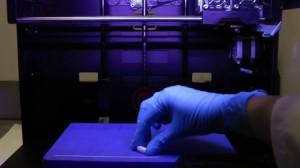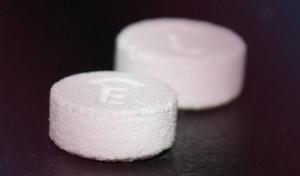 Bloomberg BNA’s Pharmaceutical Law & Industry Report was recently released, and according to attorneys the recent FDA approval of the first 3D printed drug could lead to several complicated legal, product liability and intellectual property conflicts that could derail the new technology before it even starts. Several attorneys explained to Bloomberg that using a 3D printing process for pills and drugs could potentially cause problems with identifying the actual manufacturer of the patented drug product. It is also noted that legally it would be difficult to determine who would be considered the manufacturer, specifically related to liability issues.
Bloomberg BNA’s Pharmaceutical Law & Industry Report was recently released, and according to attorneys the recent FDA approval of the first 3D printed drug could lead to several complicated legal, product liability and intellectual property conflicts that could derail the new technology before it even starts. Several attorneys explained to Bloomberg that using a 3D printing process for pills and drugs could potentially cause problems with identifying the actual manufacturer of the patented drug product. It is also noted that legally it would be difficult to determine who would be considered the manufacturer, specifically related to liability issues.
 Back in August when the Food and Drug Administration approved Aprecia Pharmaceuticals’ 3D printed drug Spritam, it was the first time that a 3D printing process had been approved for the manufacturing of a drug. Spritam was designed to be taken orally to treat adults and children with epilepsy living with partial onset seizures, myoclonic seizures and primary generalized tonic-clonic seizures. The 3D printing process was designed to enable the pill to be rapidly dissolved in the patient’s mouth, allowing it to be absorbed quicker and help prevent or reduce the effects of an oncoming seizure.
Back in August when the Food and Drug Administration approved Aprecia Pharmaceuticals’ 3D printed drug Spritam, it was the first time that a 3D printing process had been approved for the manufacturing of a drug. Spritam was designed to be taken orally to treat adults and children with epilepsy living with partial onset seizures, myoclonic seizures and primary generalized tonic-clonic seizures. The 3D printing process was designed to enable the pill to be rapidly dissolved in the patient’s mouth, allowing it to be absorbed quicker and help prevent or reduce the effects of an oncoming seizure.
St. Louis attorney Leanne M. Rakers with Harness, Dickey & Pierce spoke to Bloomberg about several of the related legal issues raised by 3D printed pills. The 3D printing process will allow pharmacists, hospitals and others to print patented drugs without the oversight of the manufacturer. That would open them up to potential lawsuits if the drug is printed incorrectly and the patient suffers harm from the improper manufacturing of their medication.
“You can imagine if the small pharmacy owner on the corner prints it incorrectly; how are you going to be able to trace it back to that pharmacy unless they come up with technology and ways to regulate how 3D printed drugs are going to be made,” Rakers explained to Bloomberg.
There is going to be a need to implement some form of regulation that will allow 3D printed drugs to properly be traced back to both the person who printed it, and the holder of the drug’s patent. Rakers says that it is important that the FDA keep up to date with modern technology and implement safeguards to protect both the consumers from potential health risks and the manufacturer from improperly placed blame. Enforcing patents will also be rendered nearly impossible because the patented drugs will be especially difficult to identify in powdered form or once consumed by the patient.
“The main intellectual property issue is being able to identify and enforce. If you can’t identify and enforce, then it makes patent law pretty much obsolete. There are going to have to be new ways to keep up with this technology,” Rakers continued.
Rakers’ concerns were shared by Philadelphia attorney James Beck for Reed Smith, who said that product liability issues aren’t generally legal issues when medications or medical devices are 3D printed by traditional manufacturers. But when the individual who is operating the printer is an outside party like a pharmacist, a doctor’s office or hospital staff, it raises the possibility that legally they would actually be considered the manufacturer.
“In classic product liability law, it’s key to determine the manufacturer. Negligence is not key to anything and just has to do with who has a recognized duty of care to someone. So you could have negligence-based standards, which do not require the designation of a specific manufacturer. It’s conceivable that a plaintiff could say that a hospital running the printer is the manufacturer, but that could run into state statutes that basically declare that a hospital is performing a service and is not a product manufacturer and that anything else is incidental to the service,” explained Beck.
 According to Beck there simply is no current case law on the matter, so he will be watching the issue closely. For the moment software isn’t technically considered a product, meaning for product liability purposes the software developer wouldn’t be considered the manufacturer. Of course Beck notes that even that could change in the future as laws are regularly amended and altered when new technology is developed.
According to Beck there simply is no current case law on the matter, so he will be watching the issue closely. For the moment software isn’t technically considered a product, meaning for product liability purposes the software developer wouldn’t be considered the manufacturer. Of course Beck notes that even that could change in the future as laws are regularly amended and altered when new technology is developed.
“Determining who the manufacturer of a 3D printed drug is, is an interesting question for which there is no legal answer. Anybody can operate the printer. The person who is going to use the product can operate the printer if they have a 3D printer and they download files from the Internet. A lot of the software is open source and is available for free on the Internet so you don’t know who put it together,” Beck said.
 Beck believes that it is entirely possible that legally the person who pushes the start button on the 3D printer could be considered the manufacturer. But it seems that you could even climb up that tree further and charge the website where the software was downloaded from. Even if product liability can’t be applied, Beck suggests that negligence certainly could be. Especially if there was a known or exploitable flaw. It is even possible that, depending on the case and the circumstances, the manufacturer of the 3D printer could be held liable. The new technology opens up several messy new avenues of potential lawsuits that it seems the FDA hasn’t taken into account.
Beck believes that it is entirely possible that legally the person who pushes the start button on the 3D printer could be considered the manufacturer. But it seems that you could even climb up that tree further and charge the website where the software was downloaded from. Even if product liability can’t be applied, Beck suggests that negligence certainly could be. Especially if there was a known or exploitable flaw. It is even possible that, depending on the case and the circumstances, the manufacturer of the 3D printer could be held liable. The new technology opens up several messy new avenues of potential lawsuits that it seems the FDA hasn’t taken into account.
While 3D printing marketing has taken the descriptor “disruptive” and made it virtually meaningless at this point, it shouldn’t be lost on the industry that 3D printing really is in fact disruptive. It may be ushering in a huge technological revolution that could potentially change the world and alter the way that we do, well, everything. But when the world changes on that level, a level unseen since the Industrial Revolution, it is going to bring along with it an entire list of complex legal issues that are almost impossible to predict. And if the industry doesn’t pay close attention to it, those legal issues could knock the new industrial revolution right off of its tracks. Let’s hear your thoughts on this story in the Medical 3D Printing forum on 3DPB.com.
Subscribe to Our Email Newsletter
Stay up-to-date on all the latest news from the 3D printing industry and receive information and offers from third party vendors.
You May Also Like
Precision at the Microscale: UK Researchers Advance Medical Devices with BMF’s 3D Printing Tech
University of Nottingham researchers are using Boston Micro Fabrication‘s (BMF) 3D printing technology to develop medical devices that improve compatibility with human tissue. Funded by a UK grant, this project...
3D Printing Webinar and Event Roundup: April 21, 2024
It’s another busy week of webinars and events, starting with Hannover Messe in Germany and continuing with Metalcasting Congress, Chinaplas, TechBlick’s Innovation Festival, and more. Stratasys continues its advanced training...
3D Printing Webinar and Event Roundup: March 17, 2024
It’s another busy week of webinars and events, including SALMED 2024 and AM Forum in Berlin. Stratasys continues its in-person training and is offering two webinars, ASTM is holding a...
3D Printed Micro Antenna is 15% Smaller and 6X Lighter
Horizon Microtechnologies has achieved success in creating a high-frequency D-Band horn antenna through micro 3D printing. However, this achievement did not rely solely on 3D printing; it involved a combination...






























